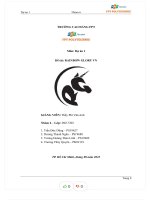x0010 csharp essentials 2nd editio morebook vn 3076
Bạn đang xem bản rút gọn của tài liệu. Xem và tải ngay bản đầy đủ của tài liệu tại đây (45.36 KB, 7 trang )
C# Essentials, 2nd Edition
Ben Albahari
Peter Drayton
Brad Merrill
Publisher: O'Reilly
Second Edition February 2001
ISBN: 0-596-00315-3, 216 pages
Concise but thorough, this second edition of C# Essentials introduces the Microsoft C#
programming language, including the Microsoft .NET Common Language Runtime (CLR) and
.NET Framework Class Libraries (FCL) that support it. This book's compact format and terse
presentation of key concepts serve as a roadmap to the online documentation included with the
Microsoft .NET Framework SDK; the many examples provide much-needed context.
My Release J 2002
For OR Forum
Preface........................................................................................................................... 4
Audience .................................................................................................................... 4
About This Book ....................................................................................................... 4
C# Online ................................................................................................................... 4
Conventions Used in This Book............................................................................. 5
How to Contact Us ................................................................................................... 7
Acknowledgments .................................................................................................... 7
Chapter 1. Introduction................................................................................................ 9
1.1 C# Language ...................................................................................................... 9
1.2 Common Language Runtime......................................................................... 10
1.3 Framework Class Library ............................................................................... 11
1.4 A First C# Program.......................................................................................... 11
Chapter 2. C# Language Reference ....................................................................... 13
2.1 Identifiers........................................................................................................... 13
2.2 Types ................................................................................................................. 13
2.3 Variables ........................................................................................................... 23
2.4 Expressions and Operators ........................................................................... 24
2.5 Statements........................................................................................................ 26
2.6 Organizing Types............................................................................................. 33
2.7 Inheritance ........................................................................................................ 35
2.8 Access Modifiers.............................................................................................. 39
2.9 Classes and Structs ........................................................................................ 41
2.10 Interfaces ........................................................................................................ 56
2.11 Arrays .............................................................................................................. 59
2.12 Enums ............................................................................................................. 61
2.13 Delegates........................................................................................................ 62
2.14 Events ............................................................................................................. 65
2.15 try Statements and Exceptions ................................................................... 67
2.16 Attributes ......................................................................................................... 71
2.17 Unsafe Code and Pointers ........................................................................... 73
2.18 Preprocessor Directives ............................................................................... 75
2.19 XML Documentation ..................................................................................... 76
Chapter 3. Programming the.NET Framework ...................................................... 82
3.1 Common Types................................................................................................ 82
3.2 Math ................................................................................................................... 87
3.3 Strings ............................................................................................................... 88
3.4 Collections ........................................................................................................ 91
3.5 Regular Expressions ....................................................................................... 97
3.6 Input/Output...................................................................................................... 99
3.7 Networking ...................................................................................................... 102
3.8 Threading ........................................................................................................ 106
3.9 Assemblies ..................................................................................................... 109
3.10 Reflection...................................................................................................... 112
3.11 Custom Attributes ........................................................................................ 118
2
3.12 Automatic Memory Management.............................................................. 124
3.13 Interop with Native DLLs ............................................................................ 127
3.14 Interop with COM......................................................................................... 133
Chapter 4. Framework Class Library Overview................................................... 137
4.1 Core Types ..................................................................................................... 137
4.2 Text .................................................................................................................. 137
4.3 Collections ...................................................................................................... 138
4.4 Streams and I/O ............................................................................................. 138
4.5 Networking ...................................................................................................... 138
4.6 Threading ........................................................................................................ 138
4.7 Security ........................................................................................................... 139
4.8 Reflection and Metadata ............................................................................... 139
4.9 Assemblies ..................................................................................................... 139
4.10 Serialization.................................................................................................. 140
4.11 Remoting ....................................................................................................... 140
4.12 Web Services ............................................................................................... 140
4.13 Data Access ................................................................................................. 141
4.14 XML ............................................................................................................... 141
4.15 Graphics........................................................................................................ 141
4.16 Rich Client Applications .............................................................................. 142
4.17 Web-Based Applications ............................................................................ 142
4.18 Globalization................................................................................................. 142
4.19 Configuration................................................................................................ 143
4.20 Advanced Component Services................................................................ 143
4.21 Diagnostics and Debugging ....................................................................... 143
4.22 Interoperating with Unmanaged Code ..................................................... 144
4.23 Compiler and Tool Support........................................................................ 144
4.24 Runtime Facilities ........................................................................................ 144
4.25 Native OS Facilities..................................................................................... 144
4.26 Undocumented Types................................................................................. 145
Chapter 5. Essential .NET Tools ........................................................................... 147
Appendix A. C# Keywords ...................................................................................... 149
Appendix B. Regular Expressions ......................................................................... 153
Appendix C. Format Specifiers .............................................................................. 156
C.1 Picture Format Specifiers ............................................................................ 157
C.2 DateTime Format Specifiers ....................................................................... 159
Appendix D. Data Marshaling ................................................................................. 161
Appendix E. Working with Assemblies ................................................................. 162
E.1 Building Shareable Assemblies .................................................................. 162
E.2 Managing the Global Assembly Cache ..................................................... 163
E.3 Using nmake .................................................................................................. 163
Appendix F. Namespaces and Assemblies ......................................................... 165
Colophon ................................................................................................................... 169
3
Preface
C# Essentials is a highly condensed introduction to the C# language and the .NET Framework.
C# and the .NET initiative were both unveiled in July 2000 at the Microsoft Professional
Developers Conference in Orlando, Florida, and shortly thereafter, the .NET Software
Development Kit (SDK) was released on the Internet.
The information in this book is based on Release Candidate 1 (RC1) of the .NET SDK released
by Microsoft in October 2001. We expect that version to be largely compatible with the final
release, but Microsoft may make minor changes that affect this book. To stay current, be sure to
check the online resources listed in Section P.3 as well as the O'Reilly web page for this book,
(see Section P.5).
Audience
While we have tried to make this book useful to anyone interested in learning about C#, our
primary audience is developers already familiar with an object-oriented language such as C++,
Smalltalk, Java, or Delphi. C# facilitates writing web applications and services, as well as
traditional standalone and client/server-based applications. Experience in any of these areas will
make the advantages of C# and the .NET Framework more immediately apparent but isn't
required.
About This Book
This book is divided into five chapters and six appendixes:
Chapter 1 orients you to C# and the .NET Framework.
Chapter 2 introduces the C# language and serves as a language reference.
Chapter 3 explains how to use C# and the .NET Framework.
Chapter 4 provides an overview of the key libraries in .NET—organized by function—and
documents the most essential namespaces and types of each.
Chapter 5 is an overview of essential .NET tools that ship with the .NET Framework SDK,
including the C# compiler and utilities for importing COM objects and exporting .NET objects.
The six appendixes provide additional information of interest to working programmers, including
an alphabetical C# keyword reference, codes for regular expressions and string formats, and a
cross reference of assembly and namespace mappings
This book assumes that you have access to the .NET Framework SDK. For additional details on
language features and class libraries covered here, we recommend the Microsoft online .NET
documentation.
C# Online
4
Since this book is a condensed introduction to C#, it cannot answer every question you might
have about the language. There are many online resources that can help you get the most out of
C#.
We recommend the following sites:
/>The Microsoft .NET Developer Center is the official site for all things .NET, including the
latest version of the .NET Framework SDK, which includes the C# compiler, as well as
documentation, technical articles, sample code, pointers to discussion groups, and thirdparty resources.
/>A complete list of third-party resources of interest to C# and .NET Framework
developers.
/>The DevelopMentor DOTNET discussion list. Possibly the best site for freewheeling
independent discussion of the .NET languages and framework; participants often include
key Microsoft engineers.
/>The O'Reilly Network .NET DevCenter, which features original articles, news, and
weblogs of interest to .NET programmers.
The O'Reilly .NET Center. Visit this page frequently for information on current and
upcoming .NET books from O'Reilly. You'll find sample chapters, articles, and other
resources.
Two articles of interest include:
/>An interview with chief C# architect Anders Hejlsberg, by O'Reilly editor John Osborn.
/>A comparison of C# to C++ and Java, by coauthor Ben Albahari.
You can find Usenet discussions about .NET in the microsoft.public.dotnet.* family of
newsgroups. In addition, the newsgroup microsoft.public.dotnet.languages.csharp specifically
addresses C#. If your news server does not carry these groups, you can find them at
news://msnews.microsoft.com.
Conventions Used in This Book
5
System.Text.RegularExpressions
System.dll
mscorlib.dll
System.Threading
System.dll
System.Timers
System.Web
System.Web.Caching
System.dll
System.Web.dll
System.Web.dll
System.Web.Configuration
System.Web.Handlers
System.Web.Hosting
System.Web.dll
System.Web.dll
System.Web.dll
System.Web.Mail
System.Web.RegularExpressions
System.Web.Security
System.Web.dll
System.Web.RegularExpressions.dll
System.Web.dll
System.Web.Services
System.Web.Services.Configuration
System.Web.Services.Description
System.Web.Services.dll
System.Web.Services.dll
System.Web.Services.dll
System.Web.Services.Discovery
System.Web.Services.Protocols
System.Web.SessionState
System.Web.Services.dll
System.Web.Services.dll
System.Web.dll
System.Web.UI
System.Web.UI.Design
System.Web.UI.Design.WebControls
System.Web.dll
System.Design.dll
System.Design.dll
System.Web.UI.HtmlControls
System.Web.UI.WebControls
System.Web.Util
System.Web.dll
System.Web.dll
System.Web.dll
System.Windows.Forms
System.Windows.Forms.ComponentModel.Com2Interop
System.Windows.Forms.dll
System.Windows.Forms.dll
System.Design.dll
System.Windows.Forms.Design
System.Windows.Forms.dll
System.Windows.Forms.PropertyGridInternal
System.Windows.Forms.dll
System.Data.dll
System.Xml
System.Xml.Schema
System.XML.dll
System.XML.dll
System.Xml.Serialization
System.Xml.XPath
System.Xml.Xsl
System.XML.dll
System.XML.dll
System.XML.dll
168
Colophon
Our look is the result of reader comments, our own experimentation, and feedback from
distribution channels. Distinctive covers complement our distinctive approach to technical topics,
breathing personality and life into potentially dry subjects.
The animals on the cover of C# Essentials are star-nosed moles (Condylura cristata). Like all
moles, star-nosed moles live primarily in underground tunnels that they dig, but they do surface to
find food. A mole's rodent-like body is covered in short, waterproof gray fur, and it is about six to
eight inches long. A notable feature is its long claws, which are perfect for digging its trenches
and foraging for food. It has small ears and eyes, and sharp, pointed teeth. A mole's eyesight and
hearing are known to be terrible.
The star-nosed mole gets its name from the approximately 25 feelers on its nose that help it find
food, primarily insects, worms, and small fish, as well as other small pond life. The star-nosed
mole is the best swimmer in the mole family and can even dive to catch a fish. It prefers to live in
wetlands but can be found in various areas of the northeastern United States and southeastern
Canada.
Moles are mammals who nurse their young, and a female mole has one litter of three to six
babies per year. This particular type of mole is considered to be less of a household pest than its
mole cousins because its mostly aquatic diet keeps it from rummaging around in backyards for
food.
Darren Kelly was the production editor, and Mary Anne Weeks Mayo was the copyeditor for C#
Essentials. Matt Hutchinson and Claire Cloutier provided quality control. Joe Wizda wrote the
index.
Ellie Volckhausen designed the cover of this book, based on a series design by Edie Freedman.
The cover image is an original engraving from The Illustrated Natural History by J. G. Wood,
published in 1865. Emma Colby and Melanie Wang produced the cover layout with QuarkXPress
4.1 using Adobe's ITC Garamond font.
David Futato designed the interior layout. Neil Walls converted the files from Microsoft Word to
FrameMaker 5.5.6, using tools created by Mike Sierra. The text font is Linotype Birka; the
heading font is Adobe Myriad Condensed; and the code font is LucasFont's TheSans Mono
Condensed. The illustrations that appear in the book were produced by Robert Romano and
Jessamyn Read using Macromedia FreeHand 9 and Adobe Photoshop 6. The tip and warning
icons were drawn by Christopher Bing. This colophon was written by Nicole Arigo.
169









